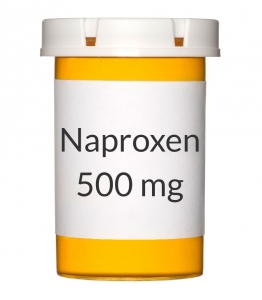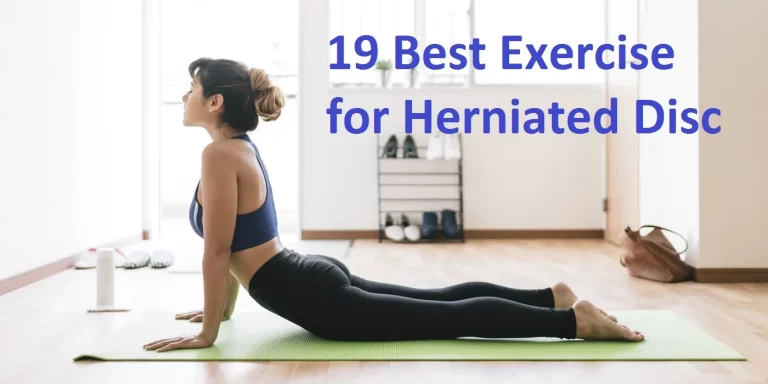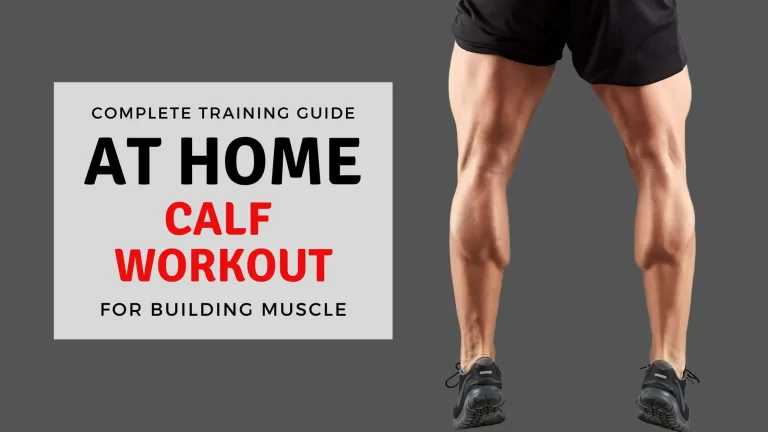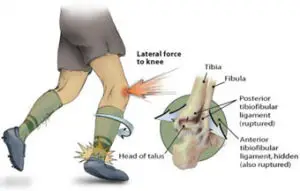At-Home 51 Best Lower Body Exercises that required no equipment
introduction
Leg exercises should not have to be confused to be functional and lower leg exercises should not require mandating any equipment either. There should be a mess of bodyweight leg exercises an individual should count to their home workout pattern that should assist an individual improving their strength in daily life and bring the strength closer to their fitness plans too.
Strong legs must be super necessary for attaining fitness purposes and creating everyday life feel a little bit more comfortable. Whether the person should weigh lifting a heavy barbell, running a marathon, walking up a getaway of stairs, accomplishing quadriceps exercises, or only selecting up a shifting child, an individual must require leg muscles to bring the position done. And the stronger their leg muscles should be, the better job they will do.
Bodyweight exercises should be real and practical, meaning that the exercises assist people to strengthen the muscles that an individual uses in their day-to-day lives. when an individual executes a squat, the person will virtually be sitting down in a fantastical chair, which would assist to improve the posture when the person truly sits in a chair. When he/she stands up from a squat, he/she goes via the heels and braces of the abdominals. the person should effectively create great rituals that convert into energies outside the gym.
Bodyweight leg exercises should also be beneficial for learning proper form before adding weights to specific motions. an individual might not be utilizing weights until they people mastered plain lunge, knee bend, and squat movements without weights. Another reward of bodyweight moves will be the person will have his/her body all the time, and it’s free to utilize, so the person should accomplish activities anywhere and anytime. If an individual obtained a supply of actions that he/she should directly do anywhere, there’s a more suitable opportunity for they would fit into the routine.
The leg-strengthening exercises would assist the person to construct strength while also making the body do more compound moves with weights. But before he/she should give the moves an attempt on the next leg day workout, read on for some tips on how to make the most of complex kinds of moves.
What kind of leg exercise should an individual do without weights or a machine?
One simple method to make equipment-free leg exercises more intense Single-leg movements referred to as sole movements, which feel harder rather than both sides movements executed with both legs due to the concentration only on the strength of a single leg. Therefore, the relatively simple perspective to elevating the intensity of the home leg workouts should be by adding exercises like lunges, single-leg glute bridges, and single-leg calf raises.
Work with just one leg.
Utilizing forceful movement, an individual might make bodyweight leg exercises more difficult. Pop squats and jump lunges should be excellent exercises that focus on strengthening the legs, improving the power, and possibly adding a little bit of cardio as well.
It’s crucial to combine squat variations like squats and lunges with hinge variations like good mornings and glute bridges while performing bodyweight leg exercises. Fagin notes that squat exercises typically target the front of the person’s legs which consists of the quadriceps, whereas flex movements focus mostly on the back which comprises the hamstrings and glutes muscle. As an outcome, an individual might engage more muscles in their legs and receive more of a well-rounded leg exercise by combining both types of moves rather than focusing solely on one leg workout.
Important note: Body weight workouts alone probably won’t be enough if the objective should be to develop significant strength and muscle. the muscles should only really grow and strengthen if they’re overloaded. And weight gain should be a common cause of overburden. Nevertheless, body weight exercises are beneficial for increasing muscular and strength endurance. Since an individual should not have to bother about weights or any other equipment and can instead completely concentrate on a sound approach, they should also have an excellent pathway to improve their fitness level.
Which leg muscle is the most difficult to work?
the hardest leg muscle to work might truly differ from person to person. However, most people occasionally find it difficult to exercise their smaller muscles. The gluteus medius is a minor but very significant lower body muscle.
The glute medius is one of the most crucial muscles in the lower body for stabilizing the hips. It is situated on the outside of the buttocks and is a member of a group of muscles known as hip abductors, which are in charge of shifting the legs out to the side and away from the center of the body. People with weak glute muscles frequently have back and hip pain, which subsequently progresses upward.
Because of this, according to, “it’s really important to not neglect the glutes and the glute medius throughout general.” Exercises that involve diagonal and/or side-to-side movements, such as lateral lunges and curtsy lunges, must help the person to tone the glute medius. Another option should be to utilize a finisher for the glutes that should be quick and efficient, like this one.
How should an individual exercise her/his legs at home?
Alternate between knee-dominant motions like a lunge and hinge movements like the good morning to create a powerful at-home leg workout continues, “It’s also a good idea to switch between unilateral exercises like single-leg glute bridges and bilateral exercises such squats.”
It should be a good idea to include some mild core workouts and upper-body motions in there if an individual should work out in a circuit style, with activities performed back to back without much recovery. Leg muscles should get some rest when the abdominal and arm muscles remain active, which will also increase the effectiveness of the workout.
Four to seven motions could be a good place to start for an at-home beginner leg workout, while there is no magic number for how many leg exercises your own at-home routine should contain. beginners to begin with two sets of 12 to 15 repetitions for every task when it comes to intensity. If an individual should like, he/she should progress from there to three sets and eventually four.
How long the exercise session should be?
Make a goal of 20 to 30 minutes. In 20 to 30 minutes, an individual should do a lot. Of course, as the person improves and gains stronger, the person should lengthen this period. There’s no of how long the leg workout may last, be sure to schedule a little warm-up first. warming up should not have to be difficult as long as the person chooses exercises that increase body warmth, move joints, and engage muscles. the person should feel satisfaction to continue with exercises.
One more thing of advice is to wait until the soreness has subsided before starting another leg-focused exercise if the person should have post-workout muscular soreness following a leg-day workout. In general, the person should give the same muscle group at least 48 hours of rest before working it again. To increase mobility, stretching your legs might be beneficial on an active recovery day. Lower body exercises the person should be done at home without any equipment.
Here are a few lower-body workouts that a person should perform at home without any special equipment.
At-home lower body exercises which required no equipment
Bodyweight Squat
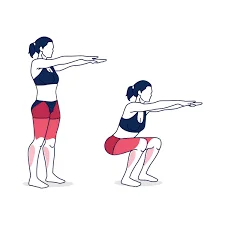
position yourself in a stand with the arms at the sides and the palms of the hands facing inward. extend the feet slightly wider than hip-width separated. The beginning is at this point.
As the person shifts his/her weight into their heels, thrust the hips back, and bend the knees to lower into a squat, engage the abdominal muscles and maintain that position with an elevated chest and a flat back. Obtain the palms together in front of the chest while bending the elbows. instead of he/she should simply keep their hands in front of the chest the whole time.
Move with the heels to stand, then clench the glutes for one repetition.
the muscle involved: semitendinosus, semimembranosus, biceps femoris,vastus lateralis,vastus intermedialis, vastus medialis, abdominals, gluteus, gastrocnemius, soleus, rectus femoris
A wall squat
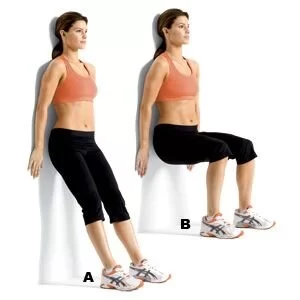
Keep the back straight and the feet hip-width apart when standing against a wall. As the person slides down the wall while bending at the knees, keep the arms by either side or on the hips. the thighs should be parallel to the ground when the person bend. To create a 90-degree angle at the knee joint at the bottom of the squat, the person might require to move the feet away from the wall. Tighten the glutes and abdominals before sliding back up the wall to the position where the person began by putting pressure via the heels.
the muscle involved: gluteus, semitendinosus, semimembranosus, biceps femoris,vastus lateralis,vastus intermedialis, vastus medialis, rectus femoris
Open-toed wide-legged squat
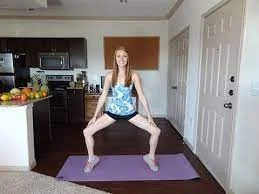
the feet should be wider than the hips as t person stand. Extend the toes. grabbing the navel toward the spine while holding the hands on the hips. As he/she extends his/her knees to the sides and squats down, rotate the pelvis forward. Keep the tailbone pointing downward and the back flat. As he/she should get again on the feet, firmly press via the heels. At the top, twist the glutes.
muscle involved : gluteus medius,gluteus minimus,gluteus Maximus,inner thigh muscle such as gracilis, obturator externus, adductor brevis, adductor longus and adductor magnus
Globet squat
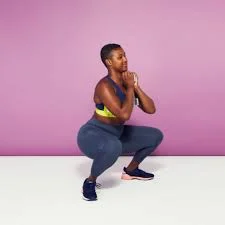
Stand with the feet wider than the hips and slightly pointed toes. With the elbows bent, bring the palms together at the chest; alternatively, position the hands on the hips. As he/she should extend her/his hips backward and bend his/her knees, tighten his/her abdominal muscles, and face front. Slowly lower the buttocks until the hips should be below the knees. Back to the beginning position, lean back, and press via the heels.
the muscle involved: Gluteus medius, gluteus minimus, gluteus maximus, vastus lateralis, vastus medialis,vastus intermedialis, and rectus femoris
Squat into the side leg lift
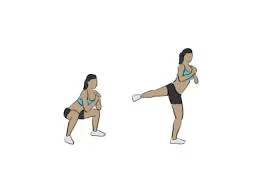
Make a squat. In order to work the outer right hip and thigh, lift the right leg out to the right as high as the hip as he/she should stand back up. Put the foot down once more, then squat downwards. repetitions, ten to fifteen times then change to the left side.
muscle involved: adductor longus, adductor brevis,adductor Magnus,gluteus Maximus,gluteus medius,gluteus minimus
Walking lunges
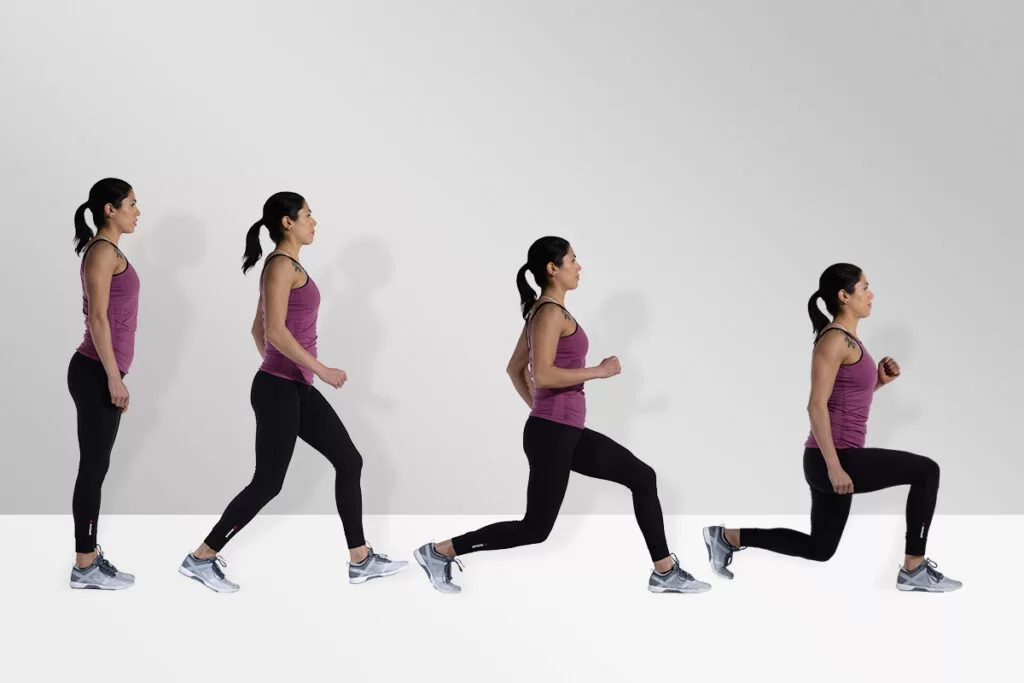
Put both feet together to begin. When the right thigh should parallel to the ground, step forward with the right foot and lunge with the right leg. To return to the beginning posture, lower himself/herself through the right heel. Now, take a forward step with the left leg, bending the left leg until the thigh appears parallel to the floor. With the right leg, keep moving forward while rotating the legs.
the muscle involved: Gluteus medius, gluteus minimus, gluteus maximus, vastus lateralis, vastus medialis,vastus intermedialis, rectus femoris, semitendinosus, semimembranosus. biceps femoris
Back lunge and lift
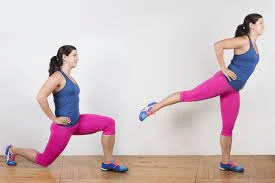
Start by standing with the soles of the feet hip-width apart. After that, take a step back with the left foot and lunge downward. Bring the left leg straight up behind the body to exercise the hamstring and glute. Press through the right heel to straighten the right leg. Before replacing sides, lower back down into a lunge and repeat 10 times.
muscle involved: quadriceps muscle such as vastus lateralis, vastus medialis,vastus intermedialis, and rectus femoris, the lesser degree also targets the calves such as gastrocnemius, soleus
gluteus muscles
groin muscles
hamstrings muscles like semitendinosus, and semimembranosus. biceps femoris
hip flexors major muscles such as sartorius, rectus femoris, tensor fascia latae, and accessory muscle of hip flexor contain Iliopsoas, Iliacus, Adductor longus, adductor brevis, adductor magnus,gracilis, pectineus, psoas major
outer thighs such as gluteus medius, gluteus minimus
Glutes bridge with a squeeze
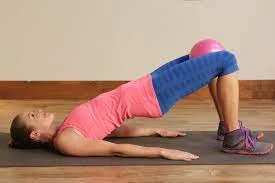
Reach the fingertips toward the heels while lying on the back with the legs bent, almost touching them. Make sure the feet should be as wide as the hips and gradually elevate the buttocks, lower back, and mid back off the ground while pulling the belly button in toward the spine. As she/he should hold the gluteal bridge with squeeze position, press the inner thighs together, then release and lower themselves back down
muscle involved: gluteus maximus
one-legged deadlift
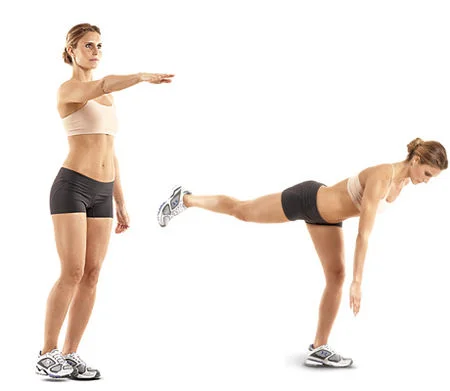
Stand with the soles of the feet hip-width apart. Utilize the right toe as a kickstand for balance and shift the weight to the left leg. Maintain the left knee flexible as he/she should begin to gradually bend at the waist. For balance, position the hands on the hips. As he/she should gradually raise the right leg upward and backward, keep moving the bend forward till the body is in a straight line from head to toe. Make sure the hips remain level with the ground. After slowing down restart the method from where the person left off
reps: 5 to 10
session 2 times a day
muscle involved: gluteus Maximus, gluteus medius, ankle muscles, core muscle
Crab walk
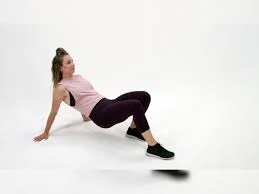
begin with Putting the hands two inches behind himself/herself and sitting down on the ground with the legs bent. Point the fingers outward from the body. Step forward with the right foot and simultaneously extend the left hand. Then move the right hand while stepping forward with the left foot. 10 times of forward walking must be required.
session: 2 to 3 times
the muscle involved: upper arm like Biceps brachii, Brachialis, Coracobrachialis, and Triceps brachii.
shoulder muscles such as rotator cuff muscles include the supraspinatus, infraspinatus, teres minor, and subscapularis
upper leg muscles such as the hamstring, quadriceps femoris
core muscles
Forward leg raises
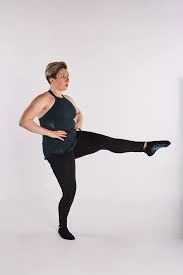
Tighten the quadriceps while standing upright and extending the right leg in front of the body. the person should know that he/she should be performing it right if his/her thigh starts to stiffen. Next, extend the leg as far as the hip before gradually bringing the leg back down.
repetition: 10 times 2 to 3 times a day
the muscle involved: hamstrings such as semitendinosus, semimembranosus, biceps femoris
calf raises

Just simply up on the tips of the toes and then go down while standing straight with the feet as wide as the hips.
repetitions: 10
session:2 to 3 times a day
muscle involved: gastrocnemius, soleus, peroneus longus, peroneus brevis, peroneus Magnus, tibialis posterior
straight leg kick back

Place the weight on the right leg and stand upright. As an individual tighten his/her gluteus, raise the left leg straight backward, bringing the left leg to a 45-degree angle with the standing leg. Ten repetitions on this side while gradually bringing the leg back down. Change sides by shifting the weight to the left leg while elevating the right leg upward and backward.
session: 2 to 3 times a day
muscle involved : gluteus Maximus, gluteus medius, gluteus minimus
The calf raises in a “V” position
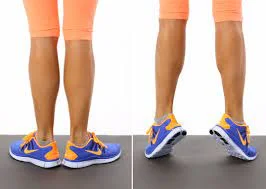
Turn the tips of the toes outward to form the letter V as he/she should stand upright with his/her feet shoulder-width separated. the hands should be on the hips. As much as he/she should, lift the heels off the ground by pressing down with the toes. Gradually lower the back downward
muscle involved: gastrocnemius
Standing hamstring curl
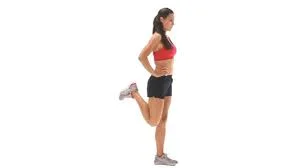
Prepare to work the backs of the legs by standing with the feet as wide apart as the hips. Connecting the back of the right leg, flex the right knee, and draw the heel toward the gluteus. Set the gluteus downward. Ten repetitions thereafter, change legs. session:2 to 3 times a day
the muscle involved: hamstrings such as semitendinosus, semimembranosus, biceps femoris, and gluteus
Mountain climbers
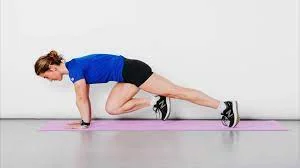
Start in a plank pose with a straight back, low hips, and a tight abdomen. Pull the right knee to the right side elbow by bringing the right side elbow under the chin. Pulling the left leg under the chest and toward the left elbow, return to the plank pose. Maintain a constant speed while an individual maintains to continue to alternate her/his legs.
repetitions: 10 to 15
2 to 3 times a day
muscle involved: shoulders such as rotator cuff muscles include the supraspinatus, infraspinatus, teres minor, subscapularis, hamstring, quadriceps femoris, triceps, core muscles
side shuffle
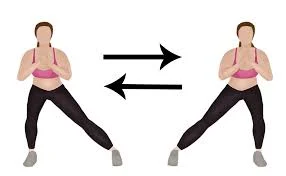
Begin by standing in a half-squat with the feet shoulder-width separated. To move the body to the right side, lift the right foot, then push off with the left side. Move for another 10 steps in the right direction, then reverse directions and move for another 10 steps to the left.
2 times a day
muscle involved: gluteus, hips, thigh muscle such as hamstrings, Adductors, quads, sartorius, pectineus, calf
Squat to oblique crunch
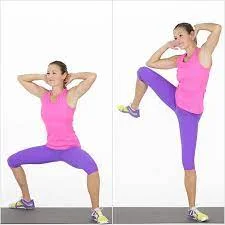
Hands should be touching in front of him/her chest as he/she should stand with his/her feet slightly greater than shoulder-width apart. This is the beginning position.
As the person moves his/her weight into his/her heels while maintaining their back flat and chest upwards, pushing his/her hips backward and bending knees to lower in the squat pose.
Return to a standing position then utilize the forward motion to tilt the left knee toward the chest. the right elbow should touch the left knee as he/she should bend toward the left knee and turn the body to the left. As he/she should lower the knee, return the hands to the beginning position.
Repeat the oblique twist on the opposite side while squatting down once again. That is one rep. Perform 10 reps
2 to 3 times a day
the muscle involved: obliques and rectus abdominis
Jump Squat
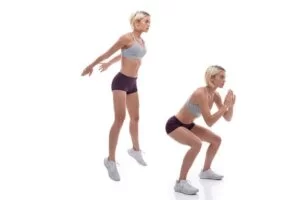
the feet should be nearly hip-width apart as the person stands. Starting point is at this point.
Sit back into a squat and lean forward at the hips. When the thighs should parallel to the ground, bend the knees.
Straighten out the legs as the person jump as high into the air as he/she should be able to do. Maintain the back straight and the chest raised while hanging the arms downward by his/her sides to create speed.
Return to the ground with a comfortable knee. That is one rep. Go precisely into the next squat.
session: 2 to 3 time
the muscle involved: gluteus, quadriceps femoris such as vastus medialis,vastus intermedialis,vastus lateralis, rectus femoris, hamstrings such as semitendinosus, semimembranosus, biceps femoris, hips
Sidestep to squat
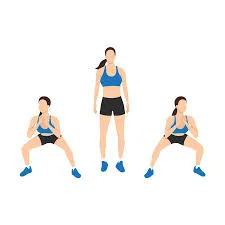
Stand with the feet together, the abdominal muscles tight, and the hands at chest level.
Step the right foot over to the right side so that the feet should be wider than hip-width separated. Then, flex at the hips to push the buttocks backward and bend both knees to lower himself/herself into a wide squat.
Bring the right foot back to the beginning position, while straightening the knees. That is one round. Perform 10 round
After executing all of the reps, transfer to the alternative side.
muscle involved: gluteus medius, quadriceps, inner thigh muscle such as adductor longus, adductor brevis, adductor magnus, pectineus,gracilis
squat to curtsy lunge
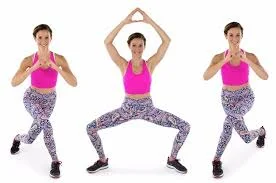
Begin with the hands positioned at chest level, the feet hip-width apart, and the abdominal muscles fully involved.
Squat by rotating the hips backward, bending both knees and rotating the hips forward until the thighs should equal the ground.
Move the right foot behind your left leg in order to stand, setting the position down behind himself/herself in a diagonal way.
Maintain the hips tight and the abdominal muscles active as he/she should flex both knees and squat down.
Return to the starting pose, squat again, and then perform the curtsy lunge again from the opposite side. That is one rep. Continue rotating the other side.
session: 2 to 3-time
muscle involved: hamstring, quadriceps, calves, gluteus
sumo Squat
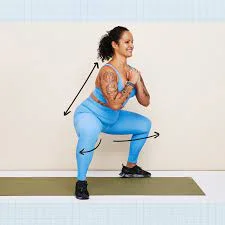
With the toes pointed out and the hands by the sides, folded in front of the chest, or held out in front of the body, take a standing position.
As the person should move the weight transferred into his/her heels, contract the abdominal muscles, and maintain an elevated, neutral back and neutral chest. As he/she should stretch his/her arms in the front, push the hips back and bend the knees to bring herself/hisself lower into a squat.
To stand, push via the soles of your feet and tighten the glutes for one repetition. Perform 10 reps
session: 2 to 3 times
muscle involved: hamstring, quadriceps, calves, gluteus, adductor longus, adductor brevis, adductor magnus, pectineus,gracilis
Eccentric Squat

stand upright With the soles of the feet hip-width apart and the abdominal muscles connected.
Push the hips back as the person will attempt to squat down gradually, bending both knees to at least 90 degrees so that both thighs should level with the floor. the speed on the path downward and should be significantly slower than it would be in a regular squat since the movement must be eccentric.
Tighten the glutes and very quickly stand to get back to the starting position. That is one rep. Perform 10 reps
session: 2 times a day
the muscle involved: quadriceps femoris contains vastus medialis,vastus intermedialis,vastus lateralis, rectus femoris
squat walk to jump
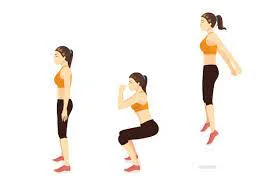
stand upright With the feet hip-width apart and the core connected.
Send the hips back and squat down into a half squat by bending the knees.
Step with the right foot to the right side while still in the squat position, permitting the left foot to follow the pattern. Take two more rightward steps with the right foot.
Jump and stretch the legs completely as the person lifts explosively. Extend the arms behind the body to gain force.
They force the person to softly touch down and instantly sit down once more. On the opposite side, repeat. That is one rep. Perform 10 rep
Alternate directions should be continued.
the muscle involved: gluteus, quads, hamstrings, hips
gluteal bridge march
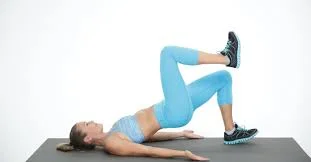
Knees bent and feet hip-width separated, resting with face up. So that the low back presses against the floor, and engages the muscles in the core.
Elevate the hips while maintaining this engaged position, squeezing the glutes muscle at the top. Stay here. Starting point at this point.
Now, elevate the right foot off the ground while raising the right knee toward the chest. pause the gluteal bridge march motion When the hip will be approximately 90 degrees from the floor.
Put the foot back down, then lift the left foot off the ground to do the opposite gluteal bridge march on the other side. It’s one rep. Execute 10 to 15 reps
As an individual march forward, and alternate usage of the feet while maintaining hips elevated.
session: 3 times a day
muscle involved: major muscle gluteus
lesser degree muscles hamstring, hips flexor, core, quads
single leg Gluteal Bridge
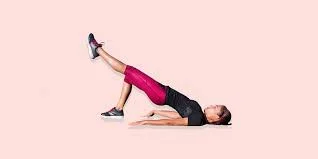
Hands at the sides of the body, knees bent, feet flat on the floor, and lying face shows the ceiling and leg upward on the floor. Put the low back against the floor by activating the core.
Lift the left foot off the ground and stretch the leg from this posture. this is the beginning position of the single-leg gluteal bridge.
Raise the hips and perform a glute bridge as push off the right foot, contract the abs, and squeeze the glutes.
Bring the pelvis back down to the floor gradually. It’s one rep.
Perform each repetition on one side.10 repetitions
session : 3 times a day
muscle involved: hamstrings, hip flexors, lower back muscles, and gluteal muscles such as gluteus Maximus, gluteus medius, gluteus minimus
Side-lying inner thigh elevation
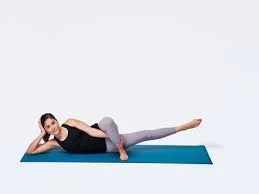
Lying down on the mat or with the body supported by the forearm the legs should be straight out and extended in front of the wall.
the upper foot should be in front of the bottom knee when the person crosses his/her upper leg over the bottom leg by bending at the knee. Starting point is at this point.
Lift the bottom leg gently and constantly up toward the ceiling. Throughout, maintain an upright body. Go back to the beginning position. That is one rep.
perform 10 to 15 reps
session: 2 to 3 times a day
muscle involved: inner thigh muscles such as adductor longus, adductor brevis, adductor magnus, pectineus,gracilis
Lateral Lunge
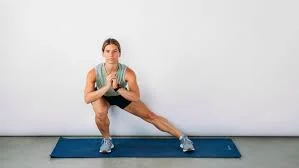
Put hands on the hips and stand with the feet together. This is the beginning position of the lateral lunge.
Make a large step to the right side, approximately two feet. Push the buttocks back, tilt forward at the hips, and bend the right knee lower into a lunge position once the foot touches the floor.
Push off the right leg to get back to the beginning position after a brief rest. It’s one rep. Execute 10 reps for a beginner
Complete all of the reps on one side before moving on to the other leg. Alternating legs should be a choice as well.
session: 2 times a day
muscle involved: hamstring, quadriceps, inner thigh, outer gluteus
Gluteal Bridge
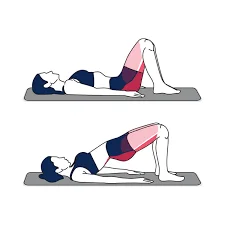
Knees bent and feet hip-width apart, lying with face showing the ceiling.
So that the low back presses against the floor, strengthening the core. Starting point is at this point.
Lift the hips while maintaining the tight position by squeezing the glutes at the top. Hold for a second, then bring the hips back down to the floor to get back to the beginning position. That is one rep. perform 10 to 15 reps
session: 2 to 3 times a day
muscle involved: gluteus maximus
in, out, center calf raises
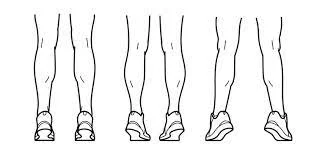
When the person alters the foot position with calf raises, he/she might more effectively target each of the two heads of the gastrocnemius muscle as well as various fibers of the deeper soleus muscle.
This variation is an excellent choice for simply executing calf raises with the toes going forward since it will assist the person use up all of the muscle fibers in the calf muscle group without weight.
Angle the foot approximately 30 degrees to the inside or outside for each of the two changes when performing the in and out variations of the calf.
This leg workout requires no equipment, and both legs should be used simultaneously by beginners. The next step will be to do single-leg calf raises in all three positions.
Here are the steps for this leg exercise using only the body weight:
- the heels should hang off the outermost portion of the platform or stage when they position the feet. If the person should have the strength, stand on one leg mainly while supporting hisself/herself with the other leg.
- By pressing into the ball of the foot to rise up onto the tips of the toes, the person should do calf raises.
- Hold the upward ankle position for two to three seconds while resting.
- Gradually decrease all the path until the heel should be well below the stair’s level and the calf muscles should be properly stretched. the bigger the range of motion an individual should move via, the more time under stress and muscle fiber the person should perform for better achievement calf strength and mass
- At least 20 to 25 repetitions should be done with the toes pointed forward.
- Then, repeat the exercise with the toes pointing inward. so that the person should be in a position of pigeon-toed
- After that variation, carry out the same exercise while duck-footed, with the toes pointing outward.
the muscle involved: gastrocnemius, soleus
single leg stair jump
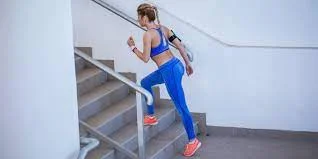
The single-leg stair jump is one of the best exercises an individual should add to a no-equipment leg workout at home as long as the home contains stairs or steps.
This plyometric workout will aid in the development of each leg’s powerful strength and power.
The movement pattern precisely simulates the musculoskeletal demands of running or jumping in sports usage since it should be a one-sided exercise.
Additionally, executing one-side exercises should usually be a better path to strengthen the muscles in the legs when working out the legs without weights because the whole body weight must be loaded onto a single leg, which should assist give the person the overload necessary to promote muscle hypertrophy and improve strength.
The steps to conduct the lower leg exercise without any equipment must be as follows:
- stand straight with perfect posture roughly one foot backward from a stair or steps
- Bend the knee on the left side and raise the left foot behind the body while standing only with the right leg.
- As he/she should lift his/her body upward and land on the sole of the foot on the step, quickly push the arms behind themselves while maintaining a strong core. Take off on the sole of the foot to activate the glutes and calf muscles.
- As the person walks upward the step earlier, bend the knee to strengthen the quadriceps and press via the foot to stand up straight on one leg. Jump back down to the beginning place with safety. On one leg, perform each repetition; after that, change the legs.
muscle involved: calves and glutes, hip flexors and also involves hamstrings and quadriceps.
Side-lying Leg raises
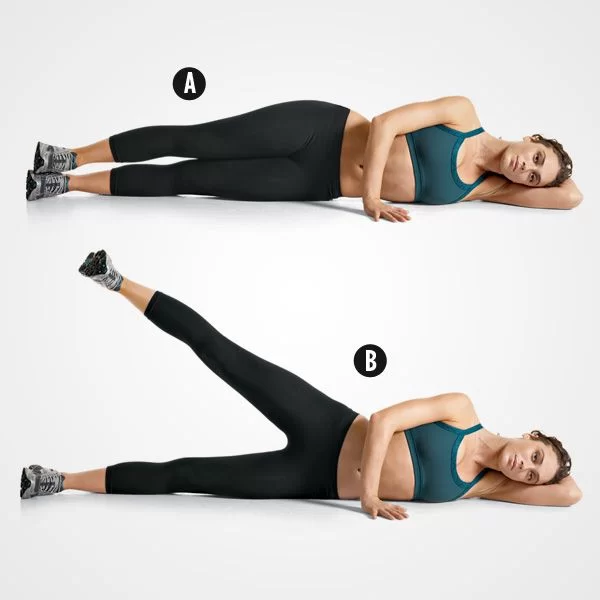
Lying on one side with the legs straight out in front of the ceiling, one leg on top of the other leg. Utilize the forearm to support the body or place the body flat on the mat. the lower leg in a bending position. this is the beginning position of side lying leg raise
Raise the top leg slowly and steadily toward the ceiling. Always lift from the hip and buttocks rather than the lower back.
Go back to the initiating point. That is one rep. Perform 10 to 15 reps
After doing all of the reps, switch to the opposite side.
session : 3 times a day
muscle involved: outer thigh muscles such as gluteus medius, gluteus minimus, hip abductor, tenor fascia latae, piriformis, sartorius, superior fibers of gluteus Maximus
curtsy Lunge
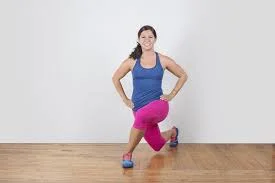
As a challenging bodyweight exercise for the legs, this is a terrific bodyweight exercise for at-home exercise for the legs without weights.
the quadriceps, glutes, hip abductors, adductors, and hamstrings will all get a good workout, and your core will be put to the test.
Put the hands on the hips or hold the hands together in front of the chest as stand with the feet shoulder-width apart. This is the beginning position.
Step back with the right foot in a diagonal pattern bending the right knee almost to the floor. the person should bend the front knee to roughly 90 degrees.
drive via the left heel.to stand back upward and come back to normal position repeat On the opposite side. That is one rep. Continue alternating.
perform 10 reps
session:2 times
Curtsy Lunge With Kick
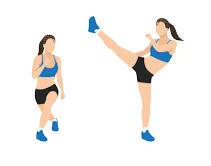
the abdominal muscles should be tight while standing with the feet hip-width apart. Starting point is at this point.
Step the right foot behind the left leg in a diagonal motion, bending both knees to lower yourself into a curtsy lunge.
In order to stand, push via the left heel. Then, stretch the right leg to the left side to attempt a little kick, directing the right foot and gently balancing for just a point as the person completely extend the leg
As he/she will instantly start the next rep, put the right foot down and place the foot after the left leg.
Switch to the further side once someone should have finished all of the reps on one side.
session: 2 times a day
the muscle involved: primary muscles: Quads, glutes, shoulders, core
accessory muscles: Upper back muscle like trapezius,latissimus dorsi, rhomboid, levator scapulae, chest muscles like pectorals, arms, hips, thighs
Tuck Jump
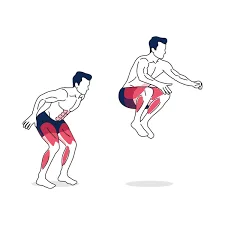
the feet should be roughly hip-width apart as anyone stands. Bend the elbows while keeping the arms by the sides and near the body so that the forearms remain straight. This is the beginning position.
flex the knees, push the butt backside in to squat position, and transfer the weight backward. Make sure the hips should not fall below the knees.
try to do his/her best performance to jump forward. Jump with the help of abs tight and the legs pointed toward the forearms. Avoid bending forward and maintaining the back straight.
Knees should be flexible as land with the feet hip-width apart. it is 1 rep perform 10 reps. Return to the squat quickly, then carry on.
session: 2 times a day
the muscle involved: gluteus, semitendinosus, semi-membranous, rectus femoris, calf, obliques, lower back, hip flexor, quadriceps femoris
Reverse Lunge to Single-Legged Hop
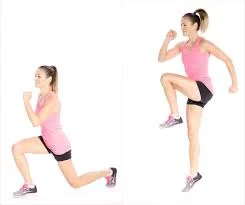
Tighten the core while standing with the feet shoulder-width apart. This is the beginning position.
With the right foot, take a step backward, landing on the sole of the right foot while maintaining the right heel off the ground.
As the person should lower into a lunge, bend both knees to 90 degrees. Lift your left arm slightly back and the right arm forward with bent elbows. Maintain the hips folded inside and abdominal muscles connected should not try to stretch the buttocks out.
Jump as high as he/she should be done while pulling the right knee toward the chest by pushing with the left foot.
Fall down softly on the left foot to a normal position, then reposition yourself to take another lunge. It’s one rep. executing 10 reps
Complete all the reps on one side. Then alters sides and repeats reverse lunge to single leg hop.
the muscle involved: quadriceps femoris, gluteus, hamstring
split squat
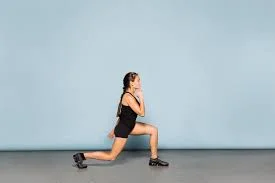
Step with the right foot forward as if the person were lunging forward while keeping the right heel fixed in place. Place the soles of the feet underneath the shoulders. This is the beginning position.
Make a 90-degree angle with the legs by bending both knees. To ensure that the back remains straight and not twisted or curved forward, the center of the chest should be erect and the entire body should be gradually forward. the right knee should be beyond the right foot, and the right quadriceps should be level with the floor. The core muscles of the body and buttocks should be active.
In order to get back to the beginning position, push via the right foot. It’s one rep.
After completing all of the reps, alter the sides.
session: 2 to 3 times a day
muscle involved: quadriceps femoris such as vastus medialis,vastus lateralis, vastus intermedialis, biceps femoris, gluteus
Alternating Forward to Reverse Lunge
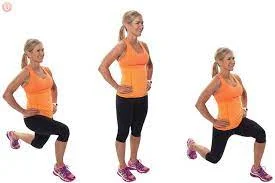
the feet should be shoulder-width apart when the person first stands. Keep the hands close to the heart. This is the beginning position.
Lift the right foot, step forward approximately two steps, and securely set the foot on the ground. the left tibia and right quadriceps should be close to the floor as the person bends both knees. To ensure that the back stays flat and not twisted or oval in shape the body should bend slightly forward. the pelvic and core should be engaged, and the right knee should be beyond the right foot.
Return to the starting position by applying pressure, then Step backward with the right foot, maintain the heel off the ground, and get back on the sole of the foot, roughly two feet. the left quad and right tibia should be nearly parallel to the floor as the person bends both knees. To ensure that the back is flat and not twisted or rounded, the body should bend gradually forward. the pelvic and core should be connected, and the left knee should be above the left foot.
To go back to the initial position, push via the heel of the left foot. It’s one rep. Perform 10 reps
After finishing all of the reps on one leg, move on to the other.
session: 1 to 2 times a day
muscle involved: quadriceps femoris, hamstring, gluteus, calf
good morning
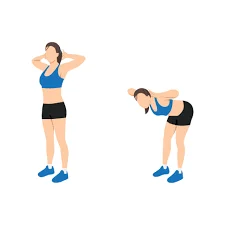
begin with the feet hip-width apart and the arms behind the head, and stand straight. this is the beginning position.
Maintaining a flat back and straight legs as the person progressively bends forward, bends at the hips, and connects the core. Once the chest will be parallel to the ground, stop the movement.
For one rep, go back to the beginning position. then Repeat 10 times.
session: 2 to 3 times a day
muscle involved: gluteus, hamstring, upper back,lattisimus dorsi, calves
Warrior Balance
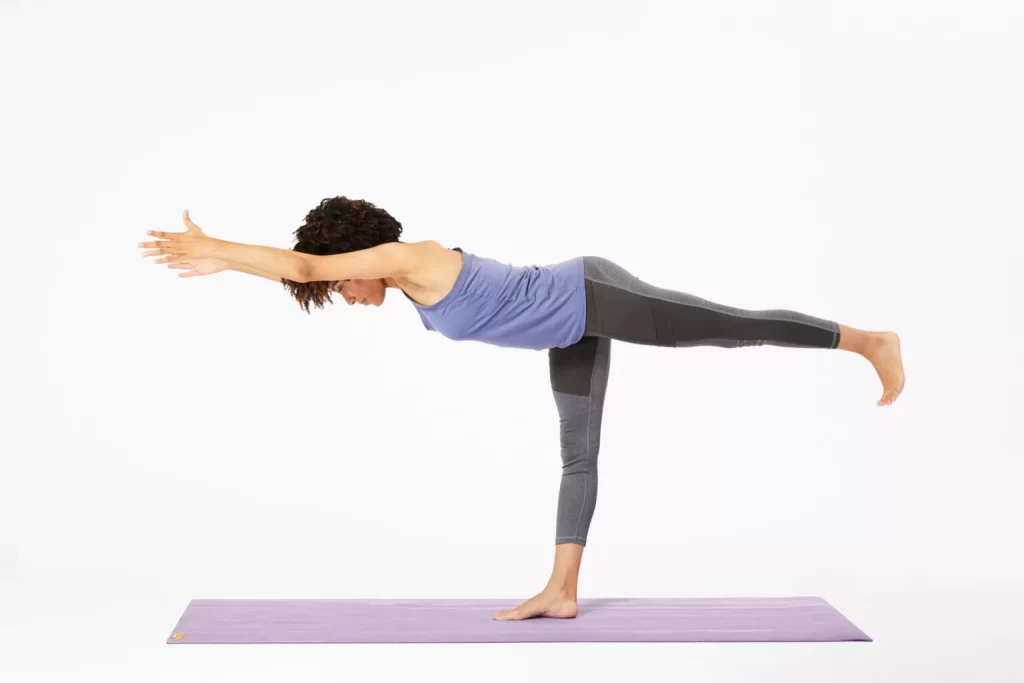
Lift the right knee to hip height in front of the body while standing on the left foot. the hands should be by the sides of the shoulder when the person flexes the elbows. This is the initial position.
As the person extends his/her right leg behind themselves, lean forward at the hips and reach out with the arms. As the body aligns with the floor, maintain the standing leg gradually bent.
pause for a second then perform a reverse warrior balance exercise to come back to normal position, .it’s one rep, perform 10 reps 2 to 3 times a day
muscle involved: hips, legs, arms, upper back
Burpees

The best lower body exercise at home leg workouts contain challenging, total-body exercises like the burpees.
Start with both hands on the surface of the floor in a low squat position.
Put the self in the push-up position by jumping the feet backward.
Perform 1 push-up, then jump back to the squat body position with the feet.
Before squatting and returning to the push-up part of the program, jump as high as an individual should.
These plyometric exercises move mixture a of squats, push-ups, and vertical jumps, working not only the leg muscles but also the core muscles, chest, shoulders, arms, and upper back.
plie squats and calf raises
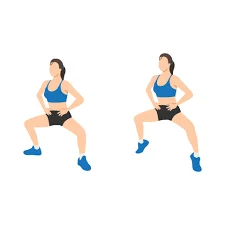
Toes pointed out, hands on hips or in front of the chest, and feet gradually wider than shoulder-width apart.
Squat down till the thighs should be level to the ground. The initial position is at this point.
Lift both of the heels off the ground while holding a squat position and hold for two seconds.
For one rep, bring the heels back down. execute 10 repetitions
two to three times per day.
the muscle involved: gluteus, calves, inner thigh
single leg lift calf Raises
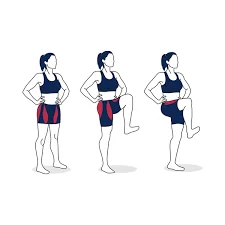
Place the lower extremities hip-width apart as he/she should stand.
Toes pointed, hands on hips or behind the head whatever keeps the person stable), lift the left knee to hip level. The beginning is at this point.
Lift the heel of the right leg off the ground as high as an individual should be able to do while maintaining balance on the left foot.
hold for three to five seconds, then descend the sole of the feet downward to the floor for 1 rep, execute 10 reps, then continue altering the sides
muscle involved: calves, tibialis anterior
Pistol Squats
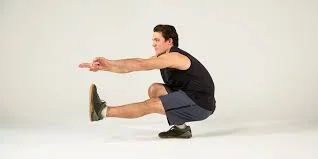
Due to the movement’s extreme strength and control requirements for the quads, glutes, hips, ankles, and core, pistol squats tend to be the most difficult leg workout exercises an individual should do without any equipment.
Put the feet together as the person standing. The beginning is at this point.
Stretch out the left leg with the foot flexed, raising it a few inches.
Twist the right knee, bring the left leg up to hip level, lean forward at the hips, and sit back into a squat position. For balance, extended the arms outward.
If anyone should attempt to bend the knee to a 90-degree angle. These are very challenging, so should not give up if the person should not be in a beginner category.
To straighten the right leg, squeeze through its heel as the person goes back to the starting position. then Continue for other reps.
session: according to the person’s capacity
jumping Lunge
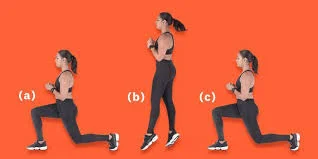
Place the feet approximately shoulder-width apart as the person stands. The beginning is at this point.
Jump the left foot forward and the right foot backward while keeping the core connected. Then, flex both knees and lower the self into a lunge.
Jump back to the beginning point with both feet.
Next, hit the right foot forward and the left foot back, then lunge to the opposite side. That is one rep. Execute 10 reps
Every time the person bends, keep jumping while switching sides.
an individual should design the jumping lunge maneuver more difficult by altering feet in the center position of the motion and instantly lowering the self into a lunge each time so the person should not jump her/his feet back together.
the muscle involved: hamstring, calves, gluteus, hip flexor
frog jump
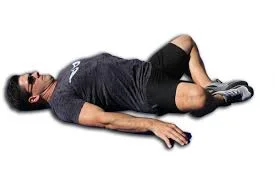
begin With the knees bent and the feet hip-width apart, lying down with faceup on the ground or a mat.
the legs should form a diamond shape when the person squeezes his/her heels together. This is the beginning point. To initiate the correct posture, bring the heels as near the pelvis as an individual should do; but, if the person wants to feel the
stretch in the glutes, he/she might require to move the pelvis further away
Lift the pelvis off the surface by contracting the glutes, then move in a straight line to the knees. At the highest point, pause for one to two seconds.
To return to the beginning posture, lower the hips. It’s one rep. perform 5 to 10 reps
session: according to the person’s capacity
muscle involved: gluteus, hip flexor, quads
inverted inner thigh openers
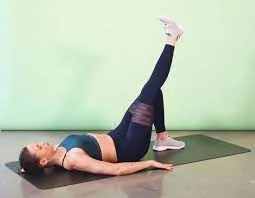
Knees in the flexed position and feet flat on the surface of the floor, lie on the back. While maintaining the thighs in contact, lift up the right leg, extending it upwards. The beginning is at this point.
maintain the lower back and hips securely positioned on the floor as the person gradually extend the right leg out to the right side for as long as the person should.
Begin by bringing the leg backward. That is one rep. Continue to perform 10 reps
Repeat on the opposite side until the person should have completed all of the reps.
muscle involved: inner thigh, outer thigh, abdominals
fire hydrant
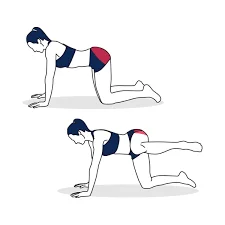
Begin on all fours with the abdominal muscles tightened and the wrists and knees under the shoulders.
Raise the right knee upwards to the side toward the ceiling while keeping the leg flexed. as the leg should be grabbed by a string
maintain the abdominis connected and be aware to not give a grant to the body to tip to the left side as raise
drop the knee to the beginning position for 1 rep and repeat the further remaining reps
complete all the repetitions on one side then change the side
muscle involved: hips, gluteus mainly gluteus medius
Donkey Kick
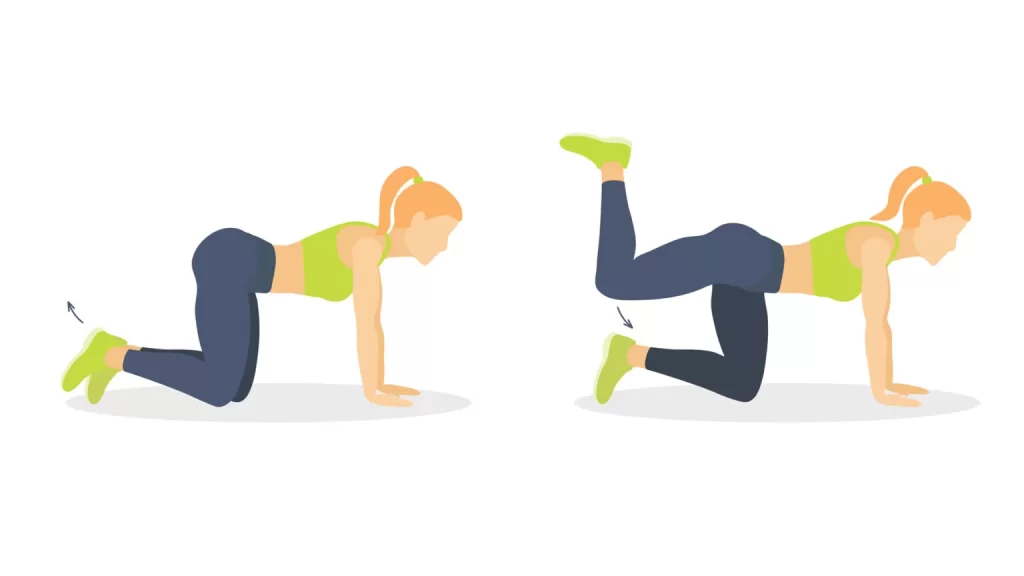
Begin on all fours with the core tightened and the wrists and knees under the shoulders.
Utilizing the glutes and hamstrings to lift the right foot upward, kick it upward and toward the ceiling.
Pause raising before extending the person’s arches to the lower back and maintain abdominal stability to avoid falling to the left side. set in mind that donkey kick is a strength workout rather than a flexibility one.
For one rep, lower the leg to the beginning position.
Perform each repetition on one side, then change to the other.
the muscle involved: gluteus medius, gluteus minimus
pop Squat With a 180-Degree Turn

the core should be tight when the person begins with the feet slightly wider than hip-width apart.
After a brief jump in position, turn 180 degrees to show the other way with the second jump.
After one more little jump, move the hips backward, bend both knees, squeeze the glutes to bring the self down, and touch the floor with one hand while simultaneously lowering into a squat position.
After standing up, quickly jump once, then twist 180 degrees to show the opposite direction on the second jump. Repeat the jump, then squat down on the opposite side.
Keep jumping and squatting while circling backward and forward.
perform 5 to 7 reps
A-skip
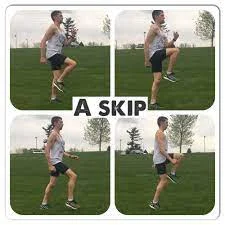
The A-skip is a traditional path and field exercise that gets the legs ready for harder effort. A-skips serve as a great warm-up activity for non-track athletes to get their bodies ready for leg exercise.
How to do the A-skip:
Place the feet hip-width apart as the person is standing.
forcefully elevate one knee while maintaining a flexed foot on the raised leg.
Pushing via the ground with the placed foot, raise the heel off the floor as the person lift the knee.
To go for advance, forcefully push that foot’s heel first to the floor once the top of the thigh will be level to the ground. When the heel touches the ground, touch the surface by standing up straight on the toes and extending the heel off the floor.
as the person touches the floor with his/her placed foot, forcefully elevate the other knee to create the next skip
allow the arms to hang normally by including the other side arm hanging upward with the other side knee
muscle involved: primarily targets the quads and to a lesser degree also targets the glutes, hamstrings, hip flexors, lower back, and outer thighs.
Health and Safety precautions
The form is essential when working on the legs. In any squat or lunge movement, the person commonly should not want her/his knees to thrust out too far beyond her/his toes. Avoid performing this to prevent adding any more pressure to the knee. Although it is suitable if this occurs by accident, the doctor would prefer this squat or lunge to occur as little as possible.
The summary
Leg exercises utilizing only the body weight should be an excellent approach to raising functional fitness and training important movement patterns.
The main movements accessible for serious bodyweight leg exercises
should be the squat and lunge patterns.
lower body program must include more exercises to raise variety, warm up, as well as improve mobility.
Bodyweight workout routines should be modified to concentrate on various fitness objectives, including strength or conditioning.
External force should ultimately be required to keep building strength.
Cardiovascular conditioning should always be achieved with bodyweight exercises.
The best part is that the person might perform these workouts at any time, any place. Attempt some of these exercises the next time he/she should require to get the blood flowing after spending too much time seated.
FAQs
Is it acceptable to exercise without equipment?
Homegrown advantages. For older persons, body-weight workouts have numerous special advantages. They are flexible in the sense that they should perform exercises anyplace without any special equipment. When making a comeback from an accident or extended absence from work, when they should need to develop endurance and confidence, body-weight exercises must be excellent.
should an individual skip the squat on leg day?
Never think that leg training sessions are useless if the person has in a circumstance where he/she must not squat. With a number of additional workouts, he/she might still increase the size and strength while concentrating on the quadriceps, hamstrings, and glutes, the three main lower body muscular groups.
what is the mean of sissy squat?
In the beginning, the knees will be slightly bent. Position. The quadriceps muscles ought to be intensely burned. a few reps later.
Will not exercising my legs cause them to become smaller?
The absence of leg exercises will not result in muscle converting to fat. However, over time, the fat cells would become larger while the muscle cells might contract. the person might become less muscular and fit as a result.
How should an individual get lose of overweight thighs?
the person must eat well, exercise, and develop the thigh muscles if he/she should want to lose thigh fat. Sumo and goblet squats might help tighten the thigh muscles and make them look smaller. Additionally, pay attention to cardio exercises like running that work on the thighs.
How should an individual get in the shape of a lower body without utilizing a gym?
bodyweight workout, Furthermore, individuals might perform these workouts anywhere without the use of any special equipment or gym clothing. Planks, pushups, squats, jumping jacks, push-up burpees, lunges, etc. are among the many options the person should have.
Why is it essential to have powerful legs?
Strong legs should be essential for supporting the body and maintaining balance. the strong legs are the foundation for lower body mobility, together with the core muscles. Additionally essential to avoiding lower back pain includes having strong legs.


